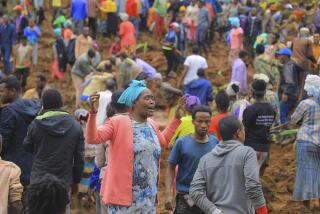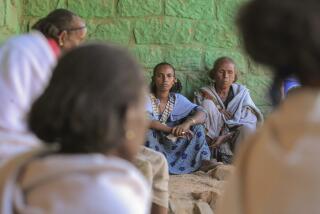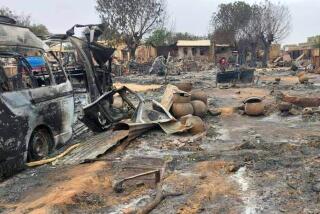Ethiopia Hits Capital of Eritrea; Talks Set for Today
ASMARA, Eritrea — Warplanes bombed a military airstrip on the outskirts of this capital city Monday, taking Ethiopia’s 2-week-old offensive deeper into Eritrean territory on the day a new round of peace talks was scheduled to begin.
The daylight raid was the first attack on Eritrea’s main city since the conflict between the two neighbors in the Horn of Africa flared two years ago. At least two civilians were reported injured.
Diplomats and political observers in Asmara, home to about 500,000 people, said Ethiopia’s attack threatened to overshadow intensifying peace negotiations and dimmed prospects for lasting stability in the region.
At the same time, fighting continued to rage at the center of Eritrea’s front line in the south, as each side pounded the other with shells and mortar fire. Asmara claimed to have repulsed an intense Ethiopian offensive a few miles from the town of Adi Quala--about 65 miles south of the capital--where dozens of bodies of what were said to be Ethiopian soldiers littered the rocky landscape.
In addition, the Ethiopian foreign minister’s late arrival Monday for peace negotiations in Algiers forced the talks’ postponement until today. U.S. mediators led by special envoy Anthony Lake--the former national security advisor--and a European Union delegation also were sent to the Algerian capital to take part in the negotiations.
Meanwhile, Ethiopia said today that it withdrew its forces from parts of Eritrea captured along the western front, saying Ethiopian troops had achieved their goals and had no interest in holding on to the territory, Associated Press reported.
The western front is only one of three areas where Ethiopia and Eritrea have fought along their poorly demarcated border.
On Monday in Asmara, the four Ethiopian MIG-23s that swept over the international airport, just three miles from the city center, fired rockets and bombed a military airstrip 400 yards to the west. Two Eritrean MIG-29s took off in quick pursuit, and the buzzing of military aircraft could be heard for much of the day.
Witnesses said they heard the jets whizzing overhead, along with loud booms, then saw a huge mushroom cloud on the horizon spewing black smoke. Sirens screamed as ambulances and fire engines rushed to the airport.
Eritrea’s Foreign Affairs Ministry said the bombing failed to damage any military installations, although a guard outpost on the periphery of the runway was demolished.
Western diplomats said their governments were assessing the security situation to determine whether to evacuate their remaining nationals from Eritrea, although most nonessential personnel were ordered to leave when the recent bout of fighting began May 12.
Still, the smoke clearing Monday revealed the barest fraction of the enormous destruction and loss of life caused by the war between the enemy neighbors.
The conflict, initially attributed to a dispute over the two countries’ poorly demarcated 620-mile border, has escalated beyond a battle for territory. Foreign political observers say Ethiopia appears bent on crushing Eritrea’s ability to launch any offensive against it. Asmara agreed last week to fully withdraw from all disputed territory, but Ethiopia’s aggression has continued.
Eritrea called the airport bombing “a senseless act of terror” and said the action underscored Ethiopia’s “malevolent intentions of wanton destruction.”
Officials in Asmara also believe that the airport attack was in revenge for Eritrea’s successful repulsion of Ethiopia on its southern front.
Remains of Fighters Dot the Cliffsides
On Monday, the stiff and bloated bodies of soldiers--Ethiopians, according to Eritrean army officials--dotted the rocky escarpment, and the stench of decaying corpses filled the air near the village of Adi Begie, less than 40 miles from Ethiopia’s mountain ranges. The remains of dozens more fighters were stuck in crevices on the escarpment, which drops steeply for several miles.
Eritrean military officials said the Ethiopian army, which began its bombardment of the region May 26, had sent more than 1,000 troops, backed by tanks, across the vast expanse of valley that separates the two countries there. The Ethiopian soldiers had tried to scale the precipitous slope but were methodically mowed down, according to Musazghi Haile, the commanding officer.
“We stayed here and challenged them here, and we took everything in this area,” said Musazghi, 39. He said intense close combat had raged on the ridge until Sunday evening, but the pounding of mortars and shells continued Monday.
Amid the hundreds of shell casings, broken canisters, scraps of old uniforms and plastic identification wallets scattered across the range lay the rock-covered graves of Eritrean soldiers. The charred and fly-infested remains of the Ethiopian forces were left to rot in the sweltering heat, but they eventually would be buried, Eritrean officers said.
Meanwhile, on the other side of the lines--in Zalambessa, a once-bustling trading center of 10,000 people--only one building, the Church of the Trinity, remained standing Monday, and local officials said it had been looted of its replica of the Ark of the Covenant and other sacred treasures.
According to Ethiopian authorities, before the Eritreans pulled out of the high plateau in the Simyen Mountains last week, they brought in a wrecking ball and razed everything in the town.
As artillery boomed to the north and Ethiopian military helicopters buzzed overhead, Hagos, a 57-year-old merchant, pedaled his bicycle to check on his one-story house and the shop in front that supported his wife and eight children.
His crinkled eyes filled with tears as he saw a long line of collapsed stone walls, twisted concrete reinforcement bars and other debris--all that was left of the place where he was born. The wiry, bearded man sank to his knees under a tree and looked up at the cloudless sky.
“I used to sell coffee, chili peppers, soap, sugar, things that like,” the merchant said after wiping his eyes with a dusty white cloth he wore around his neck. “I made about 500 birr [$70] a month, and this shop let me send my children to school. Now I have nothing left--zero.”
Ethiopian Refugees Living ‘Like Animals’
Like 500 other families from the town, Hagos’ family has been surviving since the war began two years ago in mountainside caves near Adigrat, the next town to the south of Zalambessa. Ethiopians who fled the Eritrean occupation of Zalambessa two years ago live under flimsy canopies of split saplings and plastic sheeting stretched over the caves’ overhang.
“We left everything we had to come live here like animals,” said Amete Ghebre, 52, a mother of six whose husband was fighting at the front. “When we heard Zalambessa had been freed, people began to run there. But when they reached the town, they were shocked. They started to cry, as if somebody had died. An entire town has been turned into a pile of stones.”
Ethiopian soldiers equipped with mine detectors and long knives were busy Monday with the slow, nerve-racking job of clearing the wheat and barley fields around Zalambessa of the land mines and grenades that the Eritreans had planted in the ground and rigged with tripwire as booby traps.
Ethiopia claimed it had retaken the town after a crushing attack, but there was no sign that a pitched battle had taken place. Rather, a town where Ethiopians and Eritreans once mingled and did business together appeared to have been methodically looted and destroyed by the Eritreans, then abandoned.
The scale and organization of Ethiopia’s ongoing offensive have astonished some of the soldiers at the receiving end. A former primary school north of Adigrat has been turned into a prisoner of war camp for captured members of Eritrea’s conscript army. Outside the one-story stone building, scores of young Eritrean men clad in tan and dark-green camouflage uniforms and rubber sandals sat idly in the dust Monday, surveyed by Ethiopian soldiers armed with Kalashnikov assault rifles.
“We were told before the battle of Badme [in February 1999] that new fighter planes had been bought by our government. We were told that a lot of equipment, heavy artillery and the like, had been bought,” said Mohammed Saleh, 30, one of the POWs. “But we have never seen these things.”
Yet despite the untold suffering, many Eritreans say they would rather die in battle than succumb to a form of “colonization” by Ethiopia.
Just a couple of miles back from the front line in the Eritrean town of Adi Quala--the last major town on the road to Ethiopia--volunteers from local militias, most of them older than 50, waited Monday for orders near the town’s central administration building.
“They just keep coming, person after person,” Feshatsion Okubaselassie, 51, said of the advancing adversaries.
“The Ethiopians are coming to us to fight, so we must defend our land,” added Nebi Kolkos, 48, a farmer who said he had eagerly volunteered for combat.
Said Feshatsion: “This is about our life, about our home. We have to do this.”
*
Simmons reported from Asmara and Dahlburg from Zalambessa.
More to Read
Sign up for Essential California
The most important California stories and recommendations in your inbox every morning.
You may occasionally receive promotional content from the Los Angeles Times.











